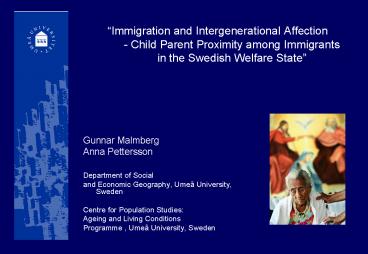Gunnar Malmberg - PowerPoint PPT Presentation
1 / 16
Title:
Gunnar Malmberg
Description:
Decreasing importance of family support. Individualisation. Migration and urbanisation ... Age of immigration. Control variables: Gender. Family members ... – PowerPoint PPT presentation
Number of Views:32
Avg rating:3.0/5.0
Title: Gunnar Malmberg
1
Immigration and Intergenerational Affection -
Child Parent Proximity among Immigrants in the
Swedish Welfare State
- Gunnar Malmberg
- Anna Pettersson
- Department of Social
- and Economic Geography, Umeå University, Sweden
- Centre for Population Studies
- Ageing and Living Conditions
- Programme , Umeå University, Sweden
2
Why study intergenerational distances?
- Intergenerational distances are important for the
possibilities of care-taking in an ageing society - 2. Distances between elderly people and their
adult children tell us something about social
relations - Social ties ? Distances
- Distances ? Contacts, care, assistance
- Welfare institutions ? Distance and contacts
3
- Swedes live farther away and
- have fewer intergenerational contacts
- Due to
- Socio-cultural values?
- Socio-economic differences?
- Institutional conditions?
Percentage having contact every
week and Percentage having children within 5 km
Italy
Sweden
Sweden
Sources SHARE-database
4
Why study immigrants intergenerational distances?
- Sweden has a large immigrant population, more
than 10 - Labour migrants in the 1950s and 1960s
- Refugees from 1970s ?
- Family unification migrants
- Recent migrants bring their parents
- Labour migrants are growing old
- An increasing number of Swedens elderly are
immigrants - Caretaking of elderly immigrants is a new
challenge - Studies of immigrants may tell us something about
the influence from socio-cultural, socio-economic
and institutional conditions
5
Growing number of aged immigrants
6
- Theories on intergenerational distances
- Modernisation theory
- Decreasing importance of family support
- Individualisation
- Migration and urbanisation
- Alternative views
- No linear process towards decreasing family
support - Different forms of intergenerational contacts in
various contexts - (Aboderin 2004)
- Intergenerational contacts are becoming more
important in American society - (Bengtson 2001)
- No increasing distances between child and
parents since the 1960s in US - (Rogerson et al 1993)
7
The immigrant population
- A large share of the immigrants come from
countries where families are crucial for
care-taking of and by the elderly - Many are not so well integrated into the Swedish
society - Many have lived in the Swedish welfare state for
a long time
8
Research questions
- Are there differences in intergenerational
distances between the immigrants and those born
in Sweden? - Are there differences between immigrants by
origin? - Do the socio-economic situation influence the
intergenerational distances? - Do we see a tendency to adaptation when living in
a society with a welfare model for care-taking?
9
- Two problems of analysing intergenerational
- distances among immigrants from registers
- Register data does not include family links for
all immigrants - Those who stay and survive are not a random
sample of the original immigrant population
10
Data
- Individual data from official Swedish registers
- Immigrants aged 65 75 living in Sweden in 2002
- Immigrated 1968 1978 (age 31 -51 and mainly
labour migrants) - People who have registered family links to adult
children (over 20) living in Sweden - n 14442
- Parents born in Sweden aged 65 75 with adult
children in 2002
11
- Socio-cultural background
- Region of origin
- Socio-economic situation
- Education level
- Income
Living within 100 meter from nearest child
- Adaptation
- Age of immigration
- Control variables
- Gender
- Family members
- Marital status
- Region etc.
12
Logistic regressions
13
Logistic regressions
14
Logistic regressions
15
Conclusions
- Intergenerational distances are larger in the
investigated immigrant population compared to
those born in Sweden, after more than 24 years in
Sweden - Socio-cultural differences still affect
intergenerational proximity - For immigrants coming from non-European
countries, high education had a negative effect
on co-residing - This indicate that socio-economic conditions
influence intergenerational distances among these
immigrants - Those who came early have somewhat shorter
distances - This could be the result of adaptation or of
selection
16
- But
- No far-reaching conclusions
- Further research?






























![[PDF] DOWNLOAD Her Quarantined Cowboy: A Wild Wests Cowboy Romance (A West PowerPoint PPT Presentation](https://s3.amazonaws.com/images.powershow.com/10048079.th0.jpg?_=20240605056)
